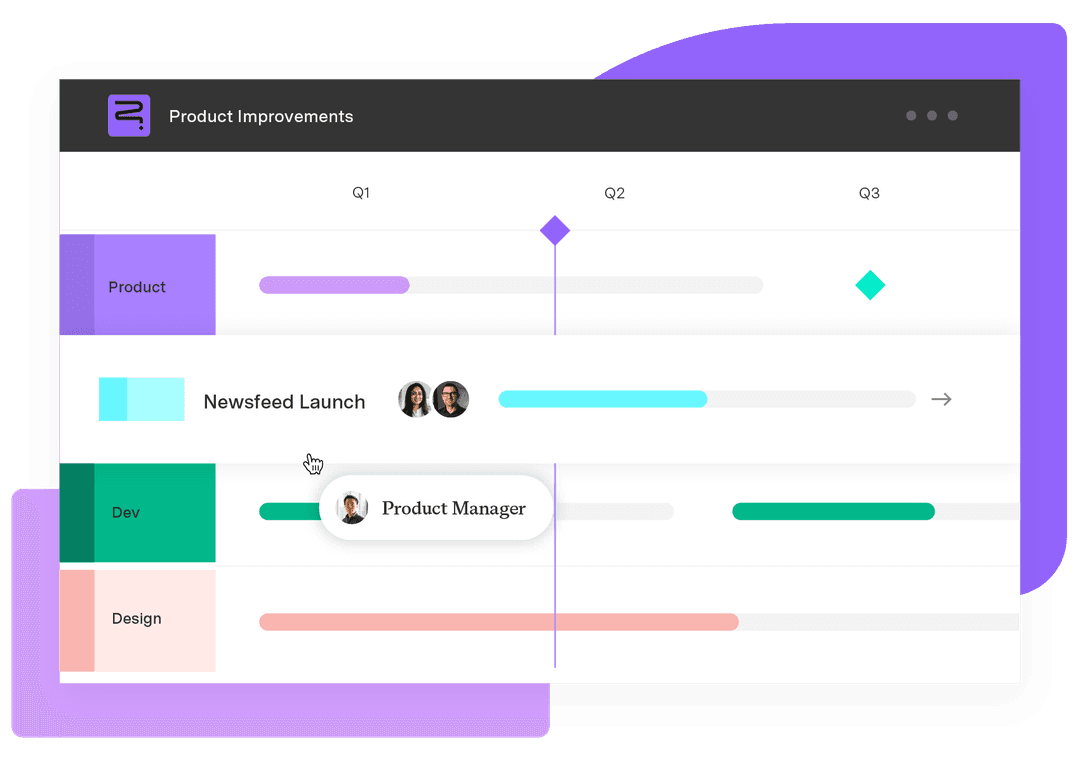Begin with the end in mind: 7 habits of highly effective people
Tempo Team
Starting with a clear goal sounds simple enough. But projects often go off track because no one agrees on what “success” actually means.
One person wants to ship fast. Another pushes for perfection. Someone else is focused on cutting costs. Before long, everyone’s headed down a different path, and the end goal starts to fade.
When that happens, progress often stalls and confusion begins to set in. That’s why it’s important to begin with the end in mind. This means stepping back, visualizing what success looks like, and making sure the entire team’s on the same page before moving forward.
When there’s a shared vision from the start, priorities are clearer – and the path to the finish line is easier to follow.
What does it mean to begin with the end in mind?
The "begin with the end in mind” concept comes from Stephen Covey, the author of “The 7 Habits of Highly Effective People.” It’s the focus of the second chapter, titled “Habit 2: Begin with the End in Mind,” where Covey encourages readers to plan with purpose and act with intention. Instead of reacting to whatever comes your way, you visualize your end goal first, then take steps that move you toward it.
So, what does it mean to begin with the end in mind? It means you:
Imagine what success looks like for you or your team
Write a personal mission statement to reflect your core values
Use that vision to prioritize tasks that matter most
Make smarter decisions because you know where you’re headed
Beginning with the end in mind is a habit that keeps you motivated, sharpens your focus, and makes your plans more effective. Whether you’re managing a project or organizing your personal objectives, starting with a clear end goal gives you direction.
Some people even imagine their own funeral or eulogy – a technique Covey suggests – to clarify what they want their life to stand for. It’s deep, but it works. By picturing the legacy you hope to leave, you’re better able to identify the values, goals, and daily decisions that align with it. In other words, when you understand the impact you want to have, it’s easier to choose actions that truly move you closer to achieving it.
The “begin with the end in mind” definition is simple: Start with a clear vision of your desired outcome, so your actions align with your end goal from the get-go.
How to practice beginning with the end in mind: 5 steps
To make the “begin with the end in mind” philosophy part of your daily routine, start by planning and acting with intention. The five steps below can help you live this habit and bring more clarity and direction to your personal and professional life:
Step 1: Visualize your success
Before you begin, pause and visualize what success looks like. Covey calls this the “mental creation” stage. Every building is drawn before it's constructed. Likewise, every effective action should begin with a mental blueprint.
Try techniques like:
Mind mapping or sketching workflows
Creating mental models to understand how things connect
Writing down what “done well” looks like
When you can imagine the outcome, you’re better equipped to work backward to create a clear approach to achieve it. Having that mental picture activates motivation and makes your goal seem more attainable.
Step 2: Set clear goals using SMART criteria
Start by defining your end goal clearly using the SMART framework:
Specific: Know exactly what you want to accomplish.
Measurable: Define how you’ll track progress.
Achievable: Keep goals realistic and attainable.
Relevant: Align them with your core values and bigger mission.
Time-bound: Set deadlines to build momentum and create a sense of direction.
For example, a vague goal like “improve team productivity” doesn’t really provide a clear path forward. But applying the SMART framework transforms it into something actionable: “Increase team productivity by 15% over the next six months by implementing weekly progress check-ins and streamlining task management.” This version is specific, measurable, achievable, relevant, and time-bound. It makes it much easier to plan, track progress, and hold your team (and yourself) accountable – while also supporting better project decisions.
Step 3: Create a mission statement or a vision statement
A mission statement is a clear, concise written declaration of your core values and purpose. It helps you and your team evaluate whether a decision moves you closer to or further from your goal. Some people even write personal or family mission statements to capture shared values and guide long-term choices at home.
A shared vision statement is just as valuable for teams. While a mission statement defines your core purpose and values – why you exist – a vision statement paints a picture of the future you’re working toward – what success looks like. A clear vision gets everyone moving in the same direction and helps prevent projects from drifting due to misaligned expectations.
Covey emphasizes this in his book for a reason: Without clarity of purpose, even the hardest work can be counterproductive.
Step 4: Build a roadmap and prioritize tasks
Now that you’ve defined your vision of success, your SMART goals, and your mission statement, you have a clear destination. The next step is to map out how to get there. Break your vision into milestones and identify key actions. Think of this as building a bridge between where you are now and where you want to be.
Tools like strategic roadmaps, agile boards, and task prioritization matrices (like the Eisenhower Matrix) help you focus not on just doing the work – but on doing the right work.
Step 5: Incorporate feedback loops for continuous alignment
Plans change. What you envisioned last month may no longer reflect your core values or your team’s priorities today. That’s why regular check-ins matter. Schedule timely touchpoints to ask yourself and your team:
Are we still on track toward our clear vision?
Has the end goal shifted?
Are we using our resources wisely?
These feedback loops help you sharpen the saw and make thoughtful adjustments, so you're working toward outcomes that truly matter to you, not just reacting to shifting demands or other people’s expectations.
Why’s it important to begin with the end in mind?
Understanding why beginning with the end in mind helps you move with intention rather than just going through the motions. It also keeps you focused on how you spend your time and energy.
According to Covey, beginning with the end in mind – a positive mental habit – lays the foundation for building a life of clarity and intention, both personally and professionally. Here’s how:
It helps you make better decisions
When you know your end goal, it’s easier to say “yes” to the right things – and “no” to everything else. That clarity acts like a filter, helping you make smarter decisions without second-guessing yourself every step of the way.
It keeps you motivated when things get tough
Motivation naturally ebbs and flows. But when you’ve taken the time to visualize your desired outcome, you’re more likely to stay the course. That vision becomes your “why” – a beacon that effective people rely on to stay grounded when the going gets rough.
It makes planning more practical
You can’t build a house without a blueprint. The same goes for your goals. When you begin with the end in mind, you gain perspective on what it’ll take to get there. That clarity helps you map out priorities, manage your time wisely, and avoid reacting under pressure.
It sets you up for long-term success
Short-term wins feel good, but long-term successes come from clarity and consistency. The habit of beginning with the end in mind helps you balance what’s urgent today with what supports your mission statement and vision for the future.
The 7 habits of highly effective people
In “The 7 Habits of Highly Effective People,” Covey offers a practical framework for living with clarity and intention. Each habit builds on the last, guiding readers from personal growth to strong relationships to long-term success.
Here’s a quick look at the seven habits and how they work together:
1. Be proactive
Being proactive means taking ownership of your life, your choices, and your responses. Rather than reacting to external circumstances, highly effective people focus on what they can control – starting with themselves.
2. Begin with the end in mind
Again, this habit is all about starting with your end goal in mind and then reverse-engineering the steps to get there. It’s what keeps projects – and people – from drifting off course. Some practical examples of beginning with the end in mind include writing a personal mission statement and mapping out a project roadmap before you start.
3. Put first things first
Once you know where you’re going, it’s time to prioritize. A helpful tool for this habit is Stephen Covey’s Time Management Matrix, which divides tasks into four categories based on urgency and importance. Covey teaches that the most effective people prioritize important but not urgent tasks – like planning, relationship building, and personal development – because these activities build long-term success. This means shifting your focus from simply reacting to what’s urgent to investing your time in what matters most.
4. Think win-win
In work and in life, collaboration often leads to better outcomes than competition. Highly effective people don’t try to “win” by outdoing others. Instead, they look for outcomes where everyone can succeed. This habit is rooted in empathy and long-term thinking – it’s about building relationships where success is shared and sustainable.
5. Seek first to understand, then to be understood
Strong communication starts with active listening. This habit challenges you to truly understand others before offering your perspective. It’s about empathy, patience, and building real connections – whether you’re leading a team or navigating personal relationships with family and friends.
6. Synergize
Synergy happens when the whole is greater than the sum of what any individual could achieve alone. It involves celebrating teamwork, diversity of thought, and a shared vision. When people with different strengths and perspectives collaborate openly, they create possibilities that wouldn't exist on their own.
7. Sharpen the saw
You can’t pour from an empty cup. This final habit is a reminder to regularly invest in yourself – physically, mentally, emotionally, and spiritually. Highly effective people don’t run themselves into the ground. Rather, they know long-term success requires regular time to rest, reflect, and grow.
Support your “begin with the end in mind” habit with Tempo
It’s one thing to set a goal. It’s another to keep your team aligned with it every step of the way.
Tempo helps you do both. With Idea Manager, you can capture and prioritize what matters, while Strategic Roadmaps allows you to visualize the big picture and break it down into actionable steps. Together, these tools help teams plan smarter and adapt to changing priorities without losing sight of their vision.
Start planning with the end in mind – try Tempo today.












































